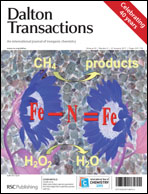N-bridged diiron tetra-tert-butylphthalocyanine activates H2O2 to form anionic hydroperoxo complex [(Pc)FeIV![[double bond, length as m-dash]](https://www.rsc.org/images/entities/char_e001.gif) N–FeIII(Pc)–OOH]− prone to heterolytic cleavage of O–O bond with the release of OH− and formation of neutral diiron oxo phthalocyanine cation radical complex, PcFeIV
N–FeIII(Pc)–OOH]− prone to heterolytic cleavage of O–O bond with the release of OH− and formation of neutral diiron oxo phthalocyanine cation radical complex, PcFeIV![[double bond, length as m-dash]](https://www.rsc.org/images/entities/char_e001.gif) N–FeIV(Pc+˙)
N–FeIV(Pc+˙)![[double bond, length as m-dash]](https://www.rsc.org/images/entities/char_e001.gif) O. ESI-MS data showed stability of the Fe–N–Fe binuclear structure upon formation of this species, capable of oxidizing methane and benzenevia O-atom transfer. The slow formation kinetics and the high reactivity preclude direct detection of this oxo complex by low temperature UV-vis spectroscopy. However, strong oxidizing properties and the results of EPR study support the formation of PcFeIV
O. ESI-MS data showed stability of the Fe–N–Fe binuclear structure upon formation of this species, capable of oxidizing methane and benzenevia O-atom transfer. The slow formation kinetics and the high reactivity preclude direct detection of this oxo complex by low temperature UV-vis spectroscopy. However, strong oxidizing properties and the results of EPR study support the formation of PcFeIV![[double bond, length as m-dash]](https://www.rsc.org/images/entities/char_e001.gif) N–FeIV(Pc+˙)
N–FeIV(Pc+˙)![[double bond, length as m-dash]](https://www.rsc.org/images/entities/char_e001.gif) O. Addition of H2O2 at −80 °C led to the disappearance of iron EPR signal and to the appearance of the narrow signal at g = 2.001 consistent with the transient formation of PcFeIV
O. Addition of H2O2 at −80 °C led to the disappearance of iron EPR signal and to the appearance of the narrow signal at g = 2.001 consistent with the transient formation of PcFeIV![[double bond, length as m-dash]](https://www.rsc.org/images/entities/char_e001.gif) N–FeIV(Pc+˙)
N–FeIV(Pc+˙)![[double bond, length as m-dash]](https://www.rsc.org/images/entities/char_e001.gif) O. In the course of this study, another high valent diiron species was prepared in the solid state with 70% yield. The Mössbauer spectrum shows two quadrupole doublets with δ1 = −0.14 mm s−1, ΔEQ1 = 1.57 mm s−1 and δ2 = −0.10 mm s−1, ΔEQ2 = 2.03 mm s−1, respectively. The negative δ values are consistent with formation of Fe(IV) states. Fe K-edge EXAFS spectroscopy reveals conservation of the diiron Fe–N–Fe core. In XANES, an intense 1s → 3d pre-edge feature at 7114.4 eV suggests formation of Fe(IV) species and attaching of one oxygen atom per two Fe atoms at the 1.90 Å distance. On the basis of Mössbauer, EPR, EXAFS and XANES data this species was tentatively assigned as (Pc)FeIV
O. In the course of this study, another high valent diiron species was prepared in the solid state with 70% yield. The Mössbauer spectrum shows two quadrupole doublets with δ1 = −0.14 mm s−1, ΔEQ1 = 1.57 mm s−1 and δ2 = −0.10 mm s−1, ΔEQ2 = 2.03 mm s−1, respectively. The negative δ values are consistent with formation of Fe(IV) states. Fe K-edge EXAFS spectroscopy reveals conservation of the diiron Fe–N–Fe core. In XANES, an intense 1s → 3d pre-edge feature at 7114.4 eV suggests formation of Fe(IV) species and attaching of one oxygen atom per two Fe atoms at the 1.90 Å distance. On the basis of Mössbauer, EPR, EXAFS and XANES data this species was tentatively assigned as (Pc)FeIV![[double bond, length as m-dash]](https://www.rsc.org/images/entities/char_e001.gif) N–FeIV(Pc)–OH which could be formed from PcFeIV
N–FeIV(Pc)–OH which could be formed from PcFeIV![[double bond, length as m-dash]](https://www.rsc.org/images/entities/char_e001.gif) N–FeIV(Pc+˙)
N–FeIV(Pc+˙)![[double bond, length as m-dash]](https://www.rsc.org/images/entities/char_e001.gif) O by hydrogen atom abstraction from a solvent molecule. Thus, despite unfavourable kinetics, we succeeded in the preparation of the first dirion(IV) phthalocyanine complex with oxygen ligand, generated in the (Pc)FeIV
O by hydrogen atom abstraction from a solvent molecule. Thus, despite unfavourable kinetics, we succeeded in the preparation of the first dirion(IV) phthalocyanine complex with oxygen ligand, generated in the (Pc)FeIV![[double bond, length as m-dash]](https://www.rsc.org/images/entities/char_e001.gif) N–FeIII(Pc) – H2O2 system capable of oxidizing methane.
N–FeIII(Pc) – H2O2 system capable of oxidizing methane.

You have access to this article
 Please wait while we load your content...
Something went wrong. Try again?
Please wait while we load your content...
Something went wrong. Try again?
![[double bond, length as m-dash]](https://www.rsc.org/images/entities/char_e001.gif) N–FeIII(Pc)–OOH]− prone to heterolytic cleavage of O–O bond with the release of OH− and formation of neutral diiron oxo
N–FeIII(Pc)–OOH]− prone to heterolytic cleavage of O–O bond with the release of OH− and formation of neutral diiron oxo ![[double bond, length as m-dash]](https://www.rsc.org/images/entities/char_e001.gif) N–FeIV(Pc+˙)
N–FeIV(Pc+˙)![[double bond, length as m-dash]](https://www.rsc.org/images/entities/char_e001.gif) O.
O. ![[double bond, length as m-dash]](https://www.rsc.org/images/entities/char_e001.gif) N–FeIV(Pc+˙)
N–FeIV(Pc+˙)![[double bond, length as m-dash]](https://www.rsc.org/images/entities/char_e001.gif) O. Addition of H2O2 at −80 °C led to the disappearance of iron
O. Addition of H2O2 at −80 °C led to the disappearance of iron ![[double bond, length as m-dash]](https://www.rsc.org/images/entities/char_e001.gif) N–FeIV(Pc+˙)
N–FeIV(Pc+˙)![[double bond, length as m-dash]](https://www.rsc.org/images/entities/char_e001.gif) O. In the course of this study, another high valent diiron species was prepared in the solid state with 70% yield. The Mössbauer
O. In the course of this study, another high valent diiron species was prepared in the solid state with 70% yield. The Mössbauer ![[double bond, length as m-dash]](https://www.rsc.org/images/entities/char_e001.gif) N–FeIV(Pc)–OH which could be formed from PcFeIV
N–FeIV(Pc)–OH which could be formed from PcFeIV![[double bond, length as m-dash]](https://www.rsc.org/images/entities/char_e001.gif) N–FeIV(Pc+˙)
N–FeIV(Pc+˙)![[double bond, length as m-dash]](https://www.rsc.org/images/entities/char_e001.gif) O by hydrogen atom abstraction from a
O by hydrogen atom abstraction from a ![[double bond, length as m-dash]](https://www.rsc.org/images/entities/char_e001.gif) N–FeIII(Pc) – H2O2 system capable of oxidizing methane.
N–FeIII(Pc) – H2O2 system capable of oxidizing methane.

 Please wait while we load your content...
Please wait while we load your content...